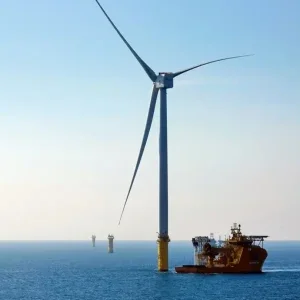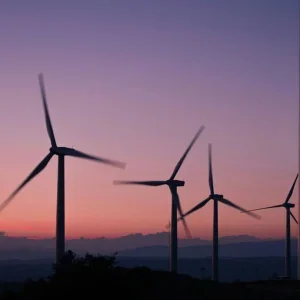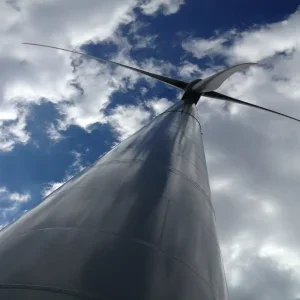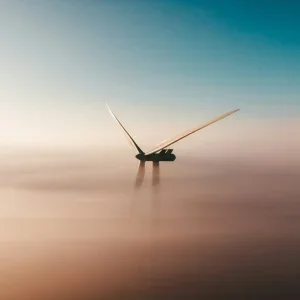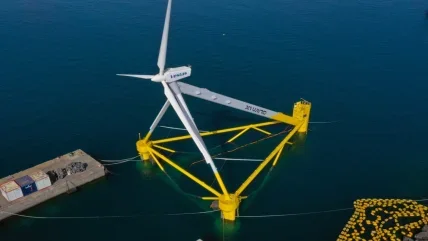
“Ten years ago, if you spoke with a professional from the wind industry and you told them that you wanted to go to deep areas with floating turbines, people would say you were you crazy,” quips João Neves, strategy and business development director of Barcelona-based technology company, X1 Wind – and he’s not joking. “I’ve heard stories about this. People would say, ‘that will never happen, that’s too difficult, [it requires] too much steel, it’s too expensive’.”
However, times change and technology changes with it, and what was once impossible can become increasingly achievable. Leading this charge is PivotBuoy, X1 Wind’s innovative single point mooring system. In October 2022, after several years in development, the company successfully installed and operated their floating wind prototype, the X30, at the PLOCAN test site in the Canary Islands. So much for “that will never happen”.
Co-founded in 2017 by Carlos Casanovas and Alex Raventos, X1 Wind are a technology-based company looking help solve the challenges of the energy transition. “We come from different backgrounds, but our common goal is to develop intelligent solutions to power the energy transition,” Neves says, “and we started with floating offshore wind.”
Whatever floats your turbine
The idea came about back in 2012, when Casanovas was specialising in tension-leg platform (TLP) design as a master’s student at MIT. “The World Bank and other sources estimate that about 80% of the wind at sea is in areas that are deeper than 60–70m,” Neves explains. “Casanovas saw that the future was of wind would be offshore and mainly in floating areas.”
Unlike more traditional monopile turbines, which must be located in shallower waters so that their tower structures can be fixed to the seabed, Casanovas wanted to develop a platform that could float in waters deeper than 50–60m. He wasn’t the first to do this – semi-submersible and spar-buoy platforms already existed, which could reach depths of more than 200m – but all these existing models have something in common. “They put towers – which is something that comes from the onshore wind industry – on top of these floating structures. But if we’re in water,” Neves says, explaining the founder’s thought process, “let’s do things differently”.
So, Casanovas and the team at X1 Wind developed PivotBuoy, a structure that combines single point mooring (SPM) with TLP to reach deeper waters, while also minimising the impact on the seabed. The main difference between PivotBuoy and other floating platforms is that, as Neves explains, the entire “structure weathervanes around a single point. So, the whole base rotates – it adapts with the wind.” Through this, the turbine maximises its ability to harness the wind, without the reliance on motorisation and the expensive active orientation that traditional turbines require.
Using considerably less steel than most other platforms – floating as well as monopile – PivotBuoy is lighter, cheaper to produce and more environmentally friendly. What is more, since it’s anchored by vertical cables instead of horizontally spread catenary lines – the enormous chains that are usually required for floating wind platforms – PivotBuoy is far less intrusive on marine life.
Backed by a €4m grant from the European Commission H2020 Program, the first PivotBuoy prototype – the X30 – was installed in the Canary Islands in June 2022 and began operating at the end of October. “That will run for about six months,” Neves says. “That’s more than we need to gather enough data. We’ve put a lot of sensors in the platform – throughout the different steel members and so on – to validate all the simulation models and all the tank testing that we’ve done in the past.”
However, X1 Wind won’t stop there. While the prototype is gathering data, the company is already working on NextFloat, another project supported by the European Commission, which will see the development of a larger, 6MW iteration of the floating platform, “to be deployed in the Mediterranean Sea, at a site called Mistral, just south of Marseilles”, Neves explains. A pre-commercial unit, this full-scale model will be tested for three years, but will be operational for up to 25 – the average lifespan of a fully commercial unit. Meanwhile, Neves is leading the business development team, who are working to build a path for the future of X1 Wind’s PivotBuoy line. “We’re already talking to clients about our commercial design – not only about the 6MW [model], but also about the even bigger unit that we are presenting in parallel, which is 15MW. And, of course, all three use the same type of tripod structure, which is where our IP resides.”
Power through
While the PivotBuoy prototype has only been operational for a matter of weeks, there’s no question that X1 Wind are blazing a trail in floating offshore wind power – but what difficulties have they faced along the way?
“When you start a company that is dedicated to hardware, it’s never easy because it’s a difficult market,” Neves notes. “So, you need to spend a lot of time testing, running a lot of simulations, and building prototypes like the one we have now in the Canary Islands.
“At the end of the day, what we are saying to the wind industry – which has already existed onshore for 40 or 50 years – is, ‘Let’s change the way we think about floating offshore platforms. Let’s move away from how we are doing things onshore in order to be more efficient offshore.’ So, this mentality change is something that we need to work on, and we need to provide the data for the industry to believe in it.”
80%
The percentage of global offshore wind resources that are in areas where water depth is greater than 60–70m.
World Bank
In addition to the conventional challenges facing a start-up company, there were also a number of unforeseen obstacles that arose in the course of the development process. “During the execution of the PivotBuoy project,” Neves says, “there was the pandemic, and then there was a volcano in the Canary Islands. It was not on the same island that we [were] in, but it meant that a lot of the offshore suppliers dropped everything that they were doing – of course, as you’d expect – and went to help these islands build emergency stations and water desalination plants and things that were urgent.” Due to these unforeseeable events, X1 wind had to work through a lack of supplier availability during this period.
Restrictions around permits can also pose an issue in the offshore wind industry – but this is a challenge that seems to have been generative for X1 Wind. “The government issues plans of maritime spatial planning – which is where they map bio-sensitive habitats, shipping routes, minimum distance to shore, and so on – and we take the areas which are not under any of these constraints,” Neves explains. “In this process, a lot of communities are involved. So, right now, we are starting those processes for the new project in the south of France and we are talking to local communities, to fisheries and to the tourism community, because you have a lot of sailing there, which is close to shore. You start understanding what the challenges are that might come from communities; and then you try to solve them.”
Learn from the past
From design, to engineering, to installation and operation – isolating challenges and finding ways to solve them is at the heart of everything that X1 Wind do. But, while the company knows that it is pioneering new approaches to offshore wind power, it also knows that it stands on the shoulders of earlier innovators. “They’ve really opened up an industry that didn’t exist 10 years ago,” Neves says. “Those technologies have been pioneering and they’ve been working well. Our view is not that there is no space for them, or that they are not economically feasible – it is that there are still efficiencies to be gained because it’s still a young industry. And we believe that our structure brings some of those efficiencies.”
As Neves notes, a lot can change in ten years and, indeed, so it has. Once dismissed as an unrealistic fantasy, floating offshore wind platforms are beginning to look like a viable – not to mention economical and sustainable – option. X1 Wind may still have a ways to go before their single-moored structure is commercially approved, but one thing looks certain – the Barcelona-based developers are ready to take on the challenge.
US DoE set to increase investment in floating offshore wind
The US Department of Energy (DoE)’s Energy Earthshots Initiative aims to accelerate breakthroughs for more abundant, affordable and reliable clean energy solutions. Achieving these targets will help the US tackle the remaining technical challenges to address the climate crisis and more quickly reach the Biden-Harris administration’s goal of equitably reaching net-zero carbon emissions by 2050, while creating good-paying jobs and growing the economy.
Much of the US’s clean energy deployment in the near term will be land-based wind and solar, but a diverse mix of clean energy resources will be required to reach that goal and the administration’s goal of decarbonising the electric grid by 2035. Offshore wind is especially well-suited to provide clean energy to densely populated coastal regions, which have a high energy demand but limited space for utility-scale land-based clean energy and transmission.
About two-thirds of the US’s offshore wind potential exists over bodies of water too deep for ‘fixed-bottom’ wind turbine foundations that are secured to the sea floor. Harnessing power over waters that are hundreds to thousands of feet deep requires floating offshore wind technology – turbines mounted to a floating foundation or platform that is anchored to the seabed with mooring lines.
At commercial scale, the costs of the first floating offshore wind projects are estimated to be more than 50% higher than the costs of fixed-bottom offshore wind. While pilot projects have already been deployed in Europe and Asia, with larger projects under development, in the US planning for development is just beginning.
The Biden-Harris administration have set a goal of reducing the cost of floating offshore wind in deep waters by more than 70%, to $45 per megawatt-hour by 2035. Investments in floating offshore wind will help usher in the US’s clean energy future by tapping into 2.8TW of potential power – more than double the country’s current electricity consumption.
These investments will advance both fixed-bottom and floating offshore wind through improved turbine performance, reduced environmental impact, and increased power production enabled by a better understanding of atmospheric science.
In September 2022, as part of an all-of-government approach to supporting US leadership in floating offshore wind, the Department of the Interior’s Bureau of Ocean Energy Management offered $50m of new funding to encourage US companies to deploy 15GW of installed floating offshore wind capacity by 2035, which is enough energy to power over five million American homes.
Source: US Department of Energy


